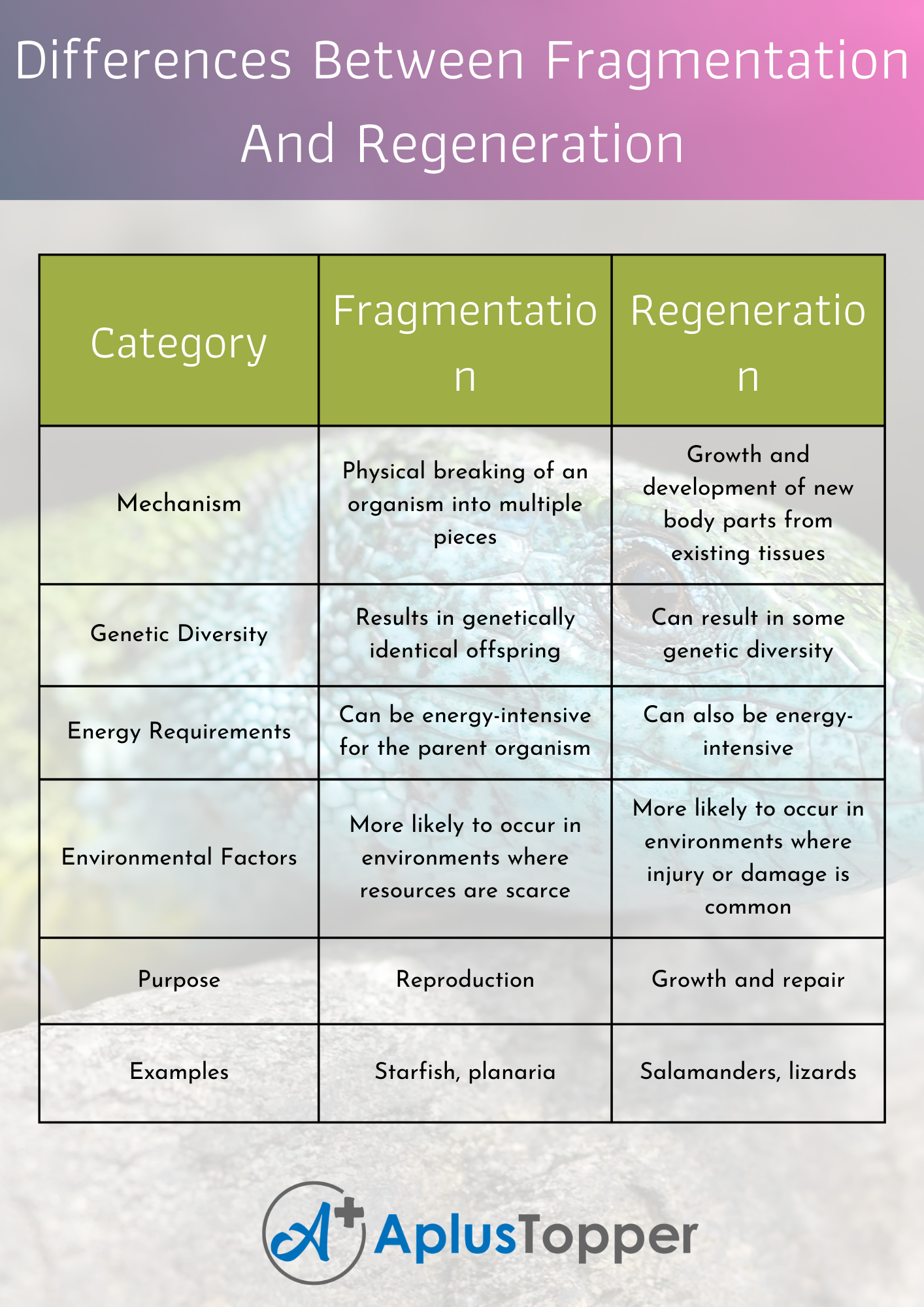Difference Between Fragmentation And Regeneration: When we think of reproduction and growth in living organisms, we often imagine traditional processes like sexual reproduction and cell division. However, some organisms have evolved unique ways to reproduce and grow, such as fragmentation and regeneration. These processes may sound similar, but they are actually quite different. In this article, we’ll explore the key differences between fragmentation and regeneration, and why understanding these processes is important.
You can read more Essay Writing about sports, events, festivals, personalities, and other differences between any of the two.
What Is Fragmentation?
Fragmentation is a form of asexual reproduction where an organism breaks into pieces, and each piece grows into a new, identical individual. This process is most commonly found in lower forms of life, such as fungi, algae, and some animals. Fragmentation is seen in a variety of organisms, but it is most commonly found in simple organisms such as fungi and algae. Some animals are also capable of fragmentation, such as starfish and some worms.
Advantages And Disadvantages Of Fragmentation
The primary advantage of fragmentation is that it allows an organism to reproduce without the need for a mate. This is particularly useful in environments where mates are scarce, or where reproduction must occur quickly to take advantage of favorable conditions. Additionally, fragmentation allows an organism to produce many offspring at once, increasing its chances of survival.
However, fragmentation also has some disadvantages. For example, the offspring produced by fragmentation are genetically identical to the parent, making them more susceptible to environmental changes and disease. Additionally, fragmentation can be energy-intensive for the parent organism, as it must expend energy to break apart its body. For example, some types of green algae can fragment into tiny pieces that can grow into new plants.
What Is Regeneration?
Regeneration is the process by which an organism regrows lost body parts. This process can occur in response to injury or damage, or as a natural part of an organism’s growth and development. Regeneration is found in many organisms, but it is particularly common in invertebrates, such as starfish, jellyfish, and flatworms. Some vertebrates, such as salamanders and certain species of fish, are also capable of regenerating body parts.
Advantages And Disadvantages Of Regeneration
One of the primary advantages of regeneration is that it allows an organism to repair itself in response to injury or damage. This can be particularly useful in environments where the injury is common, such as in coral reefs or rocky intertidal zones. Additionally, some organisms can use regeneration to replace lost body parts, such as starfish that can regenerate lost arms.
However, there are also some disadvantages to regeneration. For example, regeneration can be energy-intensive for the organism, as it must expend energy to regrow lost body parts. Additionally, not all organisms are capable of regeneration, making them more vulnerable to injury or predation. For example, some species of jellyfish can regenerate their entire bodies from a small fragment.
Differences Between Fragmentation And Regeneration
 Understanding the differences between fragmentation and regeneration is important for several reasons. First, it can help us better understand the evolutionary history of different organisms and how they have adapted to their environments. Second, it can help us develop new technologies for regenerative medicine, such as growing replacement tissues for patients with injuries or diseases. Finally, understanding the differences between these processes can help us develop more effective strategies for the conservation and management of endangered species, some of which may rely on fragmentation or regeneration for survival. While fragmentation and regeneration may sound similar, there are actually several key differences between these processes. Sure! Here’s a tabular comparison of the differences between fragmentation and regeneration:
Understanding the differences between fragmentation and regeneration is important for several reasons. First, it can help us better understand the evolutionary history of different organisms and how they have adapted to their environments. Second, it can help us develop new technologies for regenerative medicine, such as growing replacement tissues for patients with injuries or diseases. Finally, understanding the differences between these processes can help us develop more effective strategies for the conservation and management of endangered species, some of which may rely on fragmentation or regeneration for survival. While fragmentation and regeneration may sound similar, there are actually several key differences between these processes. Sure! Here’s a tabular comparison of the differences between fragmentation and regeneration:
| Parameter | Fragmentation | Regeneration |
|---|---|---|
| Mechanism | Physical breaking of an organism into multiple pieces | Growth and development of new body parts from existing tissues |
| Genetic Diversity | Results in genetically identical offspring | Can result in some genetic diversity |
| Energy Requirements | Can be energy-intensive for the parent organism | Can also be energy-intensive |
| Environmental Factors | More likely to occur in environments where resources are scarce | More likely to occur in environments where injury or damage is common |
| Purpose | Reproduction | Growth and repair |
| Examples | Starfish, planaria | Salamanders, lizards |
Conclusion
Fragmentation and regeneration are two unique processes that allow organisms to reproduce and grow in different ways. While both processes have advantages and disadvantages, they are fundamentally different in their mechanisms, purposes, and outcomes. By understanding these differences, we can better appreciate the diversity of life on Earth and develop new technologies and strategies to protect and conserve it.
Also Read: Plus One Zoology Notes Chapter 2
